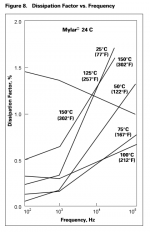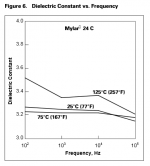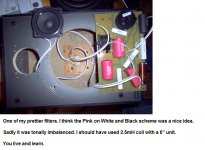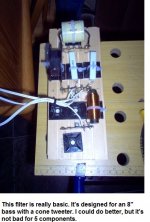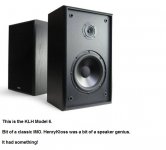You have no idea how funny this is ... 🙂

You have no idea. I'm a pretty good baiter too! 😉
@System7
This from someone that doesn't bother to measure speakers before or after modifying them......I'll take that into consideration.
I'll just wait till someone comes up with some honest testing thank you.
This from someone that doesn't bother to measure speakers before or after modifying them......I'll take that into consideration.
I'll just wait till someone comes up with some honest testing thank you.
David,
you can't change people just by telling them to. You ought to be
changing yourself and if you do it the right way, they will notice
it and approach you.
This is a scientifically approved method which works 100 %
and comes with lifetime money back guarantee.
You mean compromise? No thanks, I conside that selling out.
You have no idea. I'm a pretty good baiter too! 😉
Troll you mean?
You mean compromise? No thanks, I conside that selling out.
This was not what I had in mind. I get the feeling that you somehow
feel threatened by people having different perspective.
It can easily happen to you that you do more harm than good to
the opposing side, although you might not be aware of it.
Personally, I would never believe a person or give another thought
to whatever this person may have to say on any subject if this individual
was trying to do it in an unacceptable manner.
Personally, I would never believe a person or give another thought
to whatever this person may have to say on any subject if this individual
was trying to do it in an unacceptable manner.
Very much agreed !
Fortunately we have that nice tool called "ignore list" which makes
many threads a lot more readable.
Capacitors and damping factor (DF).
I think system7 is actually referring to Dielectric Absorption (DA), not DF.
Dielectric absorption - Wikipedia, the free encyclopedia
I think system7 is actually referring to Dielectric Absorption (DA), not DF.
Dielectric absorption - Wikipedia, the free encyclopedia
Dissipation Factor, not Damping Factor. Think "loss tangent."
I think you're right. Nevertheless I was correct about a percentage DF and a loss angle. 😱
We have confirmation of Mylar film properties from DuPont here. 1-2% DF and a similar fluctuation in Dielectric Constant. Polypropylene is an order of magnitude better. But still, tiny effects which would be negated by any series resistance in the filter.
Attachments
...... But still, tiny effects which would be negated by any series resistance in the filter.
Perhaps that's exactly the point resident troll, DavidL has been making (i.e. not receiving objective proof those small differences can be heard)?
Last edited:
But still, tiny effects which would be negated by any series resistance in the filter.
Where you really see those differences is in comparison to bipolar electrolytics or metallized vs. foil. Boutique caps can add in mechanical resonances, but that's a different story.
Perhaps that's exactly the point resident troll, DavidL has been making (i.e. not receiving objective proof those small differences can be heard)?
So I'm a resident troll for asking valid questions? Nice.
Gosh do you think that maybe people can't hear differences in a real world situation where the cap is in circuit? Golly who would have thought.
But then we have the "everybody knows" statement from earlier. Perhaps everybody doesn't know so much.
Last edited:
A troll really is someone who derails a thread. Especially if you reply. 😡
Let's approach this as if we know nothing about it. 🙂
We are struggling to think of a physical mechanism that will make a difference with goodish film capacitors. Resistors are even harder to fathom except for temperature effects increasing resistance.
Cheapie ferrite coils might have all sorts of mechanical resonances IMO. That slug of ferrite with high permeability is a feeling some drive or push from the copper coil. It's how it works really. I looked this up, and AFAIK, the permeability of ferrite is about 50, which translates as the square root for, say, sevenfold increase in inductance.
Action equals reaction according to one of Newton's laws, so the mechanical forces and energy in the coil at -3dB point might be the same as in the drive unit. Quite considerable in other words. I suppose this goes for capacitors too.
I think what we're looking for is mechanical rattles and singing and microphonic effects in any component including cables. Recall that any polarised component can be a microphone.
Here's £12,000 worth of Duelund (The Rolex of components...LOL) crossover splendour, well worth reading:
duelund project
All quite fascinating. The speaker gains "Darkness" or quietness between notes apparently. It's a quality we all have heard occasionally and it's worth pursuing. We could shoot the breeze about how to get the best out of a crossover later. I can think of a few cheap tricks that could help. Perhaps you can too. 😎
Let's approach this as if we know nothing about it. 🙂
We are struggling to think of a physical mechanism that will make a difference with goodish film capacitors. Resistors are even harder to fathom except for temperature effects increasing resistance.
Cheapie ferrite coils might have all sorts of mechanical resonances IMO. That slug of ferrite with high permeability is a feeling some drive or push from the copper coil. It's how it works really. I looked this up, and AFAIK, the permeability of ferrite is about 50, which translates as the square root for, say, sevenfold increase in inductance.
Action equals reaction according to one of Newton's laws, so the mechanical forces and energy in the coil at -3dB point might be the same as in the drive unit. Quite considerable in other words. I suppose this goes for capacitors too.
I think what we're looking for is mechanical rattles and singing and microphonic effects in any component including cables. Recall that any polarised component can be a microphone.
Here's £12,000 worth of Duelund (The Rolex of components...LOL) crossover splendour, well worth reading:
duelund project
All quite fascinating. The speaker gains "Darkness" or quietness between notes apparently. It's a quality we all have heard occasionally and it's worth pursuing. We could shoot the breeze about how to get the best out of a crossover later. I can think of a few cheap tricks that could help. Perhaps you can too. 😎
Have I? Would I recognise that?It's a quality we all have heard occasionally
I think what we're looking for is mechanical rattles and singing and microphonic effects in any component including cables. Recall that any polarised component can be a microphone.
That's why rational designers avoid boutique or fashion components and use solid, well-made, truly engineered and mass-produced parts.
Well, I'm interested where you flippin' crossover geniuses would spend more money here. Tell me. 🙂
First of all I'd buy a mic/preamp and measure the drivers and go from there but we know you consider that building a "laboratory" and not on your to do list.🙄
A troll really is someone who derails a thread. Especially if you reply. 😡
My remarks were on topic. "Capacitor Quality" not my fault I didn't go along with the sheep with "everyone knows"
- Status
- Not open for further replies.
- Home
- Loudspeakers
- Multi-Way
- Capacitor quality for crossover
